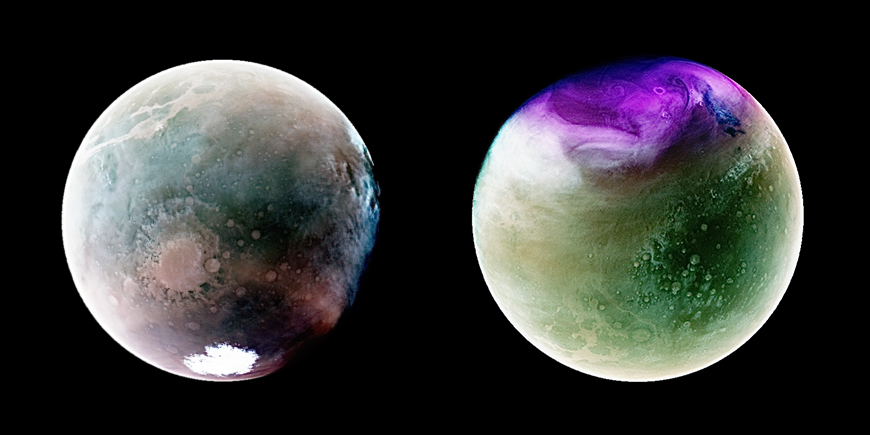The MAVEN spacecraft has taken two new ultraviolet images of Mars, revealing new details and features of the Red Planet
Maven (Mars Atmosphere and Volatile EvolutioN) is a space mission that is part of the Mars Scout programme and consists of a spacecraft that entered orbit around Mars on 21 September 2014.
The mission
The mission aims to study Mars’ upper atmosphere, ionosphere and interactions with the Sun and solar wind to understand how and why the Red Planet lost much of its atmosphere.
The IUVS Instrument
Onboard Maven is the Imaging Ultraviolet Spectrograph (IUVS) instrument, which can measure wavelengths between 110 and 340 nanometres that lie outside the visible spectrum. To make these wavelengths visible to the human eye and easier to interpret, the images have been rendered and scaled to longer wavelengths, typically represented in red, green and blue.
With this colour combination, atmospheric ozone appears purple, clouds and haze appear white or blue, while the rock surface may appear tan or green, depending on how the images have been optimised to enhance contrast and reveal detail.
Thanks to this technique, it was possible to obtain a global view of Mars in 2022 and 2023, when the planet was near the opposite ends of its elliptical orbit.
The stunning images
The first image was taken in July 2022, during the southern hemisphere’s summer season, which occurs when Mars passes close to the Sun and is caused by the tilt of the planet’s rotational axis.

In this view, the Argyre Basin, one of the deepest craters on Mars, appears in the lower left, shrouded in atmospheric haze (in light pink). The deep canyons of Valles Marineris are seen in the upper left, filled with coloured clouds (in light brown). The southern polar icecap is visible at the bottom (in white), its extent greatly reduced by the summer heat.
Summer warming and dust storms push water vapour to very high altitudes, explaining the increased hydrogen loss at this time of year detected by the spacecraft.
The second image shows the northern hemisphere of Mars and was taken in January 2023, after Mars has passed the farthest point in its orbit from the Sun.

In this image you can see that the rapid seasonal changes in the northern polar region cause an abundance of white clouds, and the deep canyons of Valles Marineris appear brown in the lower left, along with many other craters. Here, ozone, which appears magenta in this ultraviolet view, has accumulated during the cold polar nights of the northern winter and is then destroyed by chemical reactions with water vapour in the northern spring.


